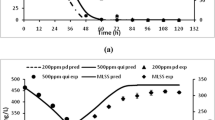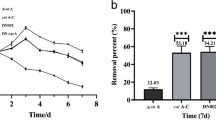Abstract
A bacterial strain Citrobacter sp. HJS-1 was discovered from the sludge in a drainage canal of a coal mine. Firstly, its biodegradation capacity for benzo[a]pyrene (BaP) was detected under different concentrations. The results proved that the strain possessed excellent biodegradation capacity for BaP with high-efficiency degradation rates ranging from 78.9 to 86.8%. The highest degradation rate was observed in the low-concentration sample, and the high-concentration BaP had a slight influence on the biodegradation capacity due to the potential toxicity of BaP and its oxygen-containing derivatives. Meanwhile, the degradation test for the other five aromatic hydrocarbons (2- to 4-ring) proved that the strain had a comprehensive degradation potential. To clarify the biodegradation mechanism of BaP, a dioxygenase structure was constructed by homology modeling. Then, the interactions between dioxygenase and BaP were researched by molecular simulation. Combined with the identification of the vital BaP-cis-7,8-dihydrodiol intermediate and the interaction analysis, the initial oxidation mode and the binding site of BaP were revealed in the dioxygenase. Taken together, this study has offered a way to understand the biodegradation process of BaP and its interaction mechanism based on experimental and theoretical analysis.






Similar content being viewed by others
Data availability
Not applicable.
References
Bergmann F, Selesi D, Weinmaier T, Tischler P, Rattei T, Meckenstock RU (2011) Genomic insights into the metabolic potential of the polycyclic aromatic hydrocarbon degrading sulfate-reducing Deltaproteobacterium N47. Environ Microbiol 13:1125–1137. https://doi.org/10.1111/j.1462-2920.2010.02391.x
Bhatt KK, Lily MK, Joshi G, Dangwal K (2018) Benzo(a) pyrene degradation pathway in Bacillus subtilis BMT4i (MTCC 9447). Turk J Biochem 43:693–701. https://doi.org/10.1515/tjb-2017-0334
Bugg T, Foght JM, Pickard MA, Gray MR (2001) Uptake and active efflux of polycyclic aromatic hydrocarbons by Pseudomonas fluorescens LP6a. Appl Environ Microbiol 66:5387–5392. https://doi.org/10.1128/AEM.66.12.5387-5392.2000
Cerniglia CE (1993) Biodegradation of polycyclic aromatic hydrocarbons. Curr Opin Biotechnol 4:331–338. https://doi.org/10.1016/0958-1669(93)90104-5
Chen S, Yin H, Ye J, Peng H, Liu Z, Dang Z, Chang J (2014) Influence of co-existed benzo [a] pyrene and copper on the cellular characteristics of Stenotrophomonas maltophilia during biodegradation and transformation. Bioresource Technol 158:181–187. https://doi.org/10.1016/j.biortech.2014.02.020
Cheng P, Lin Z, Zhao X, Waigi MG, Vasilyeva GK, Gao Y (2022) Enhanced transformation capability towards benzo (a) pyrene by Fe (III)-modified manganese oxides. J Hazard Mater 431:128637. https://doi.org/10.1016/j.jhazmat.2022.128637
Coleman NV, Spain JC (2003) Distribution of the coenzyme M pathway of epoxide metabolism among ethene-and vinyl chloride-degrading Mycobacterium strains. Appl Environ Microbiol 69:6041–6046. https://doi.org/10.1128/AEM.69.10.6041-6046.2003
Ferraro DJ, Gakhar L, Ramaswamy S (2005) Rieske business: structure-function of Rieske non-heme oxygenases. Biochem Biophys Res Commun 338:175–190. https://doi.org/10.1016/j.bbrc.2005.08.222
Frank EG, Sayer JM, Heiko K, Eiji O, Haruo O, Jerina DM, Roger W (2002) Translesion replication of benzo[a]pyrene and benzo[c]phenanthrene diol epoxide adducts of deoxyadenosine and deoxyguanosine by human DNA polymerase. Nucleic Acids Res 30:5284–5292. https://doi.org/10.1093/nar/gkf643
Grishchenkov V, Slepen'kin A, Boronin A (2002) Anaerobic degradation of biphenyl by the facultative anaerobic strain Citrobacter freundii BS2211. Appl Biochem Microbiol 38:125–128. https://doi.org/10.1023/A:1014350230764
Grosser RJ, Warshawsky D, Robievestal J (1991) Indigenous and enhanced mineralization of pyrene, benzo[a]pyrene, and carbazole in soils. Appl Environ Microbiol 57:3462–3469. https://doi.org/10.1128/aem.57.12.3462-3469.1991
Guo J, Wen X (2021) Performance and kinetics of benzo(a)pyrene biodegradation in contaminated water and soil and improvement of soil properties by biosurfactant amendment. Ecotox Environ Safe 207:111292. https://doi.org/10.1016/j.ecoenv.2020.111292
Jin JN, Yao J, Liu WJ, Zhang QY, Liu JL (2017) Fluoranthene degradation and binding mechanism study based on the active-site structure of ring-hydroxylating dioxygenase in Microbacterium paraoxydans JPM1. Environ Sci Pollut Res 24:363–371. https://doi.org/10.1007/s11356-016-7809-4
Kahla O et al (2021) Efficiency of benthic diatom-associated bacteria in the removal of benzo (a) pyrene and fluoranthene. Sci Total Environ 751:141399. https://doi.org/10.1016/j.scitotenv.2020.141399
Karlsson A, Parales JV, Parales RE, Gibson DT, Eklund H, Ramaswamy S (2003) Crystal structure of naphthalene dioxygenase: side-on binding of dioxygen to iron. Science 299:1039–1042. https://doi.org/10.1126/science.1078020
Kotoky R, Pandey P (2020) Difference in the rhizosphere microbiome of Melia azedarach during removal of benzo(a)pyrene from cadmium co-contaminated soil. Chemosphere 258:127175. https://doi.org/10.1016/j.chemosphere.2020.127175
Kuppusamy S, Thavamani P, Megharaj M, Lee YB, Naidu R (2016) Isolation and characterization of polycyclic aromatic hydrocarbons (PAHs) degrading, pH tolerant, N-fixing and P-solubilizing novel bacteria from manufactured gas plant (MGP) site soils. Environ Technol Inno 6:204–219. https://doi.org/10.1016/j.eti.2016.04.006
Laskowski RA, MacArthur MW, Moss DS, Thornton JM (1993) PROCHECK: a program to check the stereochemical quality of protein structures. J Appl Crystallogr 26:283–291. https://doi.org/10.1107/S0021889892009944
Leng Q, Mu J, Yang G (2021) Efficient anaerobic bioremediation of high-concentration benzo [a] pyrene in marine environments. Environ Pollut 284:117210. https://doi.org/10.1016/j.envpol.2021.117210
Letunic I, Bork P (2021) Interactive Tree Of Life (iTOL) v5: an online tool for phylogenetic tree display and annotation. Nucleic Acids Res 49:W293–W296. https://doi.org/10.1093/nar/gkab301
Lu QY, Chen KY, Long Y, Liang XJ, He BY, Yu LH, Ye JS (2019) Benzo(a)pyrene degradation by cytochrome P450 hydroxylase and the functional metabolism network of Bacillus thuringiensis. J Hazard Mater 366:329–337. https://doi.org/10.1016/j.jhazmat.2018.12.004
Ma J, Xu L, Jia L (2013) Characterization of pyrene degradation by Pseudomonas sp. strain Jpyr-1 isolated from active sewage sludge. Bioresource Technol 140:15–21. https://doi.org/10.1016/j.biortech.2013.03.184
Marquès M, Mari M, Audí-Miró C, Sierra J, Soler A, Nadal M, Domingo JL (2016) Photodegradation of polycyclic aromatic hydrocarbons in soils under a climate change base scenario. Chemosphere 148:495–503. https://doi.org/10.1016/j.chemosphere.2016.01.069
Martin F, Malagnoux L, Violet F, Jakoncic J, Jouanneau Y (2013) Diversity and catalytic potential of PAH-specific ring-hydroxylating dioxygenases from a hydrocarbon-contaminated soil. Appl Microbiol Biotechnol 97:5125–5135. https://doi.org/10.1007/s00253-012-4335-2
Min J, Lin D, Zhang Q, Zhang J, Yu Z (2012) Structure-based virtual screening of novel inhibitors of the uridyltransferase activity of Xanthomonas oryzae pv. oryzae GlmU. Eur J Med Chem 53:150–158. https://doi.org/10.1016/j.ejmech.2012.03.051
Nzila A, Musa MM (2021) Current status of and future perspectives in bacterial degradation of benzo[a]pyrene. Int J Env Res Pub He 18. https://doi.org/10.3390/ijerph18010262
Porter LL, Rose GD (2011) Redrawing the Ramachandran plot after inclusion of hydrogen-bonding constraints. Proc Natl Acad Sci USA 108:109–113. https://doi.org/10.1073/pnas.1014674107
Rentz AJ, Alvarez JJ, Pedro , Schnoor L, Jerald (2008) Benzo[a]pyrene degradation by Sphingomonas yanoikuyae JAR02. Environ Pollut 151:669-677. https://doi.org/10.1016/j.envpol.2007.02.018
Saravanakumar K et al (2022) Impact of benzo [a] pyrene with other pollutants induce the molecular alternation in the biological system: existence, detection, and remediation methods. Environ Pollut:119207. https://doi.org/10.1016/j.envpol.2022.119207
Schneider J, Grosser RJ, Jayasimhulu K, Xue WL, Warshawsky D (1996) Degradation of pyrene, benz[a]anthracene, and benzo [a] pyrene by mycobacterium sp strain rjgii-135, isolated from a former coal gasification site. Appl Environ Microb 62:13–19. https://doi.org/10.1128/aem.62.1.13-19.1996
Seo JS, Keum YS, Li QX (2009) Bacterial degradation of aromatic compounds. Int J Env Res Pub He 6:278–309. https://doi.org/10.3390/ijerph6010278
Shen J, Huang L, Zhou P, Quan X, Puma GL (2017) Correlation between circuital current, Cu (II) reduction and cellular electron transfer in EAB isolated from Cu (II)-reduced biocathodes of microbial fuel cells. Bioelectrochemistry 114:1–7. https://doi.org/10.1016/j.bioelechem.2016.11.002
Toyama T et al (2011) Accelerated biodegradation of pyrene and benzo [a] pyrene in the Phragmites australis rhizosphere by bacteria-root exudate interactions. Water Res 45:1629–1638. https://doi.org/10.1016/j.watres.2010.11.044
Vilar S, Cozza G, Moro S (2008) Medicinal chemistry and the molecular operating environment (MOE): application of QSAR and molecular docking to drug discovery. Curr Top Med Chem 8:1555–1572. https://doi.org/10.2174/156802608786786624
Wang X, Sun J, Liu R, Zheng T, Tang Y (2022) Plant contribution to the remediation of PAH-contaminated soil of Dagang Oilfield by Fire Phoenix. Environ Sci Pollut R 29:43126–43137. https://doi.org/10.21203/rs.3.rs-570890/v1
Wu M, Chen L, Tian Y, Ding Y, Dick WA (2013) Degradation of polycyclic aromatic hydrocarbons by microbial consortia enriched from three soils using two different culture media. Environ Pollut 178:152–158. https://doi.org/10.1016/j.envpol.2013.03.004
Yan Z et al (2017) Interconnection of key microbial functional genes for enhanced benzo[a]pyrene biodegradation in sediments by microbial electrochemistry. Environ Sci Technol 51:8519–8529. https://doi.org/10.1021/acs.est.7b00209
Yrjälä K, Keskinen AK, Åkerman ML, Fortelius C, Sipilä TP (2010) The rhizosphere and PAH amendment mediate impacts on functional and structural bacterial diversity in sandy peat soil. Environ Pollut 158:1680–1688. https://doi.org/10.1016/j.envpol.2009.11.026
Zhang J, He Y, Yan X, Qu C, Qi P (2019) Two novel CYP3A isoforms in marine mussel Mytilus coruscus: Identification and response to cadmium and benzo[a]pyrene. Aquat Toxicol 214:105239. https://doi.org/10.1016/j.aquatox.2019.105239
Acknowledgements
We thank Henan University of Technology for support of the experimental site, and all funds for their support of the study.
Funding
This work was supported by grants from the National Natural Science Foundation of China (No. 41907302), the Fundamental Research Funds for the Henan Provincial Colleges and Universities in Henan University of Technology (No. 2018QNJH10), the Doctoral Scientific Research Start-up Foundation from Henan University of Technology (No. 2017BS027), and the Training Program for Young Backbone Teachers of Henan University of Technology (No. 21420112).
Author information
Authors and Affiliations
Contributions
Jingnan Jin: methodology, conceptualization, funding acquisition, visualization, formal analysis, project administration, writing—original draft. Yahui Shi, Baozhong Zhang, and Dongjin Wan: resources, investigation, data curation, formal analysis, writing—review and editing. Qingye Zhang: software, visualization.
Corresponding author
Ethics declarations
Ethics approval and consent to participate
Not applicable.
Consent for publication
Not applicable.
Competing interests
The authors declare no competing interests.
Additional information
Responsible Editor: Robert Duran
Publisher’s note
Springer Nature remains neutral with regard to jurisdictional claims in published maps and institutional affiliations.
Highlights
• Citrobacter sp. HJS-1 was first applied in benzo[a]pyrene-degrading process.
• Benzo[a]pyrene-cis-7,8-dihydrodiol was determined as a key intermediate.
• Homology modeling technology was used to construct the target dioxygenase.
• A degradation pathway of benzo[a]pyrene was proposed in the strain HJS-1.
Supplementary information
Rights and permissions
Springer Nature or its licensor (e.g. a society or other partner) holds exclusive rights to this article under a publishing agreement with the author(s) or other rightsholder(s); author self-archiving of the accepted manuscript version of this article is solely governed by the terms of such publishing agreement and applicable law.
About this article
Cite this article
Jin, ., Shi, Y., Zhang, B. et al. An integrated method for studying the biodegradation of benzo[a]pyrene by Citrobacter sp. HJS-1 and interaction mechanism based on the structural model of the initial dioxygenase. Environ Sci Pollut Res 30, 85558–85568 (2023). https://doi.org/10.1007/s11356-023-28505-w
Received:
Accepted:
Published:
Issue Date:
DOI: https://doi.org/10.1007/s11356-023-28505-w




